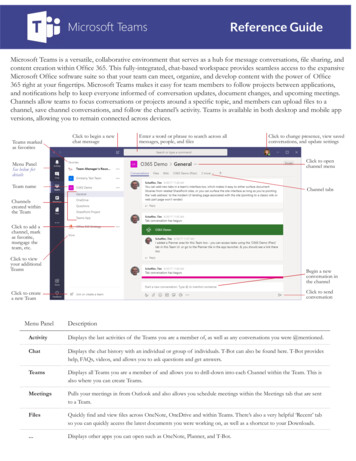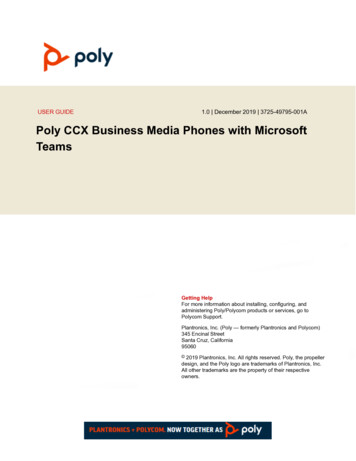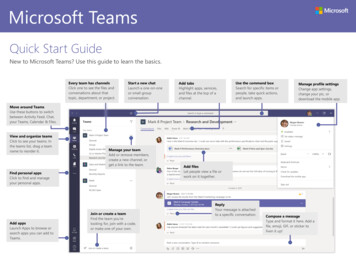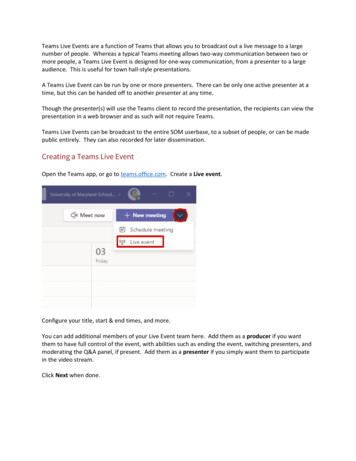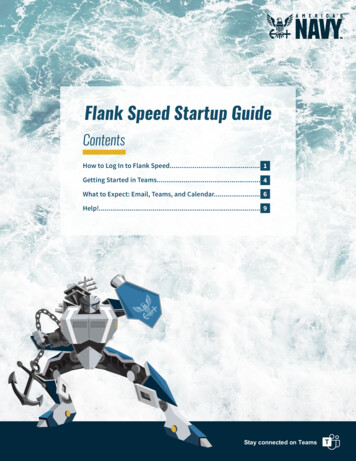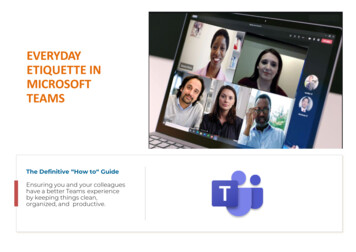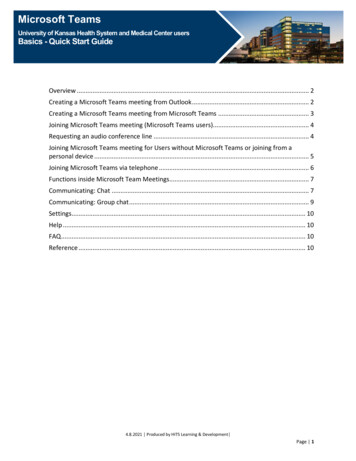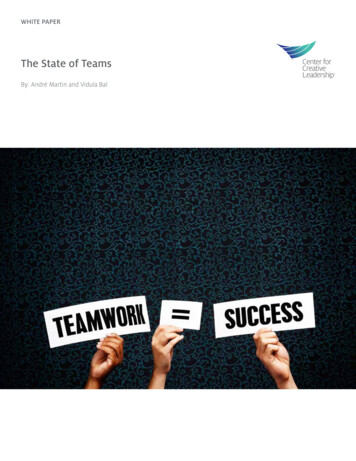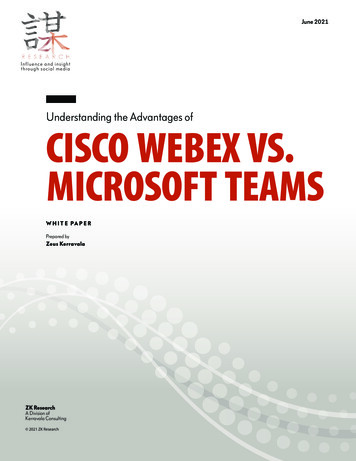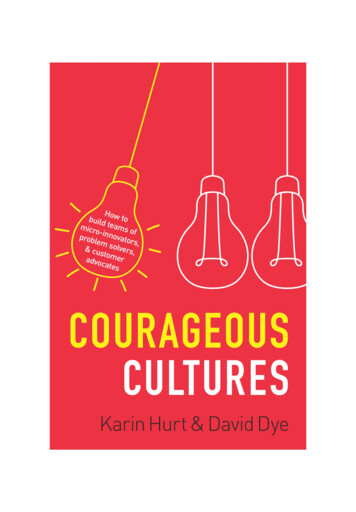
Transcription
COURAGEOUSCULTURESHow toBuild Teams ofMicroinnovators,Problem Solvers,and CustomerAdvocatesKARIN HURT & DAVID DYECourageous 9781400219537 all 1p r2.indd 73/5/20 3:55 PM
Copyright 2020 by Karin Hurt and David DyeAll rights reserved. No portion of this book may be reproduced, stored in a retrievalsystem, or transmitted in any form or by any means—electronic, mechanical,photocopy, recording, scanning, or other—except for brief quotations incritical reviews or articles, without the prior writtenpermission of the publisher.Published by HarperCollins Leadership, an imprint of HarperCollins Focus LLC.Any internet addresses, phone numbers, or company or product information printedin this book are offered as a resource and are not intended in any way to be or toimply an endorsement by HarperCollins Leadership, nor does HarperCollinsLeadership vouch for the existence, content, or services of these sites,phone numbers, companies, or products beyond the life of this book.ISBN TK (eBook)ISBN 978-1-4002-1953-7 (HC)Library of Congress Control Number: 2020930371Printed in the United States of America20 21 22 23 LSC 10 9 8 7 6 5 4 3 2 1Courageous 9781400219537 all 1p r2.indd 83/5/20 3:55 PM
To our children, Averie, Ben, and Sebastianfor the courage to believe, work, andcreate a better tomorrow.Courageous 9781400219537 all 1p r2.indd 93/5/20 3:55 PM
Praise forCOURAGEOUS CULTURES“Silence isn’t always golden. Effective organizations need peopleto speak up. Courageous Cultures is the ultimate guide to buildinga workplace environment that values outspokenness. By following the guidance in this savvy book, you’ll attract first-rate talent,serve your customers better, and liberate people to perform theirbest.”—D A N I E L H . P I N K , #1 New York Times bestsellingauthor of When, Drive, and To Sell Is Human“Hurt and Dye offer leaders a wonderfully practical road map forhow to get the most from their people—by creating a culturewhere safe silence dies and small acts of courage compound toincrease innovation, problem solving, and customer advocacy. Ifyou want to increase contribution and multiply the capability ofyour team, Courageous Cultures is a must-read.”—L I ZW I S E M A N , New York Timesbestsellingauthor of Multipliers and Rookie Smarts“Imagine if you could cast a magic spell over your entire team andsuddenly all the complainers became problem solvers, the safelysilent became innovators, and your bystanders became upstanders. Courageous Cultures, by Karin Hurt and David Dye, will teachyou how to cast that spell. Unlike other management tomes thatare short on specifics, this book gives you the specific advice, action plan, and templates to transform your organization.”—K E V I NKRUSE,CEO of LEADx andNew York Times bestselling authorCourageous 9781400219537 all 1p r2.indd 33/5/20 3:55 PM
“Courageous Cultures offers a compelling and actionable roadmapfor business leaders to tap into the energy and wisdom lying justbelow the surface within their own organizations. With databacked insights and a straightforward approach, Courageous Cultures will help leaders create a strong culture where the greatideas brewing in the minds of knowledgeable frontline workersare always welcomed and fully encouraged by every manager. Ina business environment faced with continually shifting customerexpectations and rapidly changing competitive forces, no leadershould be without this valuable resource.”—R A N D YOOSTRA,President and CEOof ProMedica Health System“In today’s uncertain times, courage is indispensable to effectiveleadership. Without a culture of courage, leaders cannot lead organizations to seize opportunities for growth that change brings.This book offers simple steps on how leaders can nurture a boldorganizational culture that encourages people to speak up, takesmart risks, innovate, become problem solvers, and seize competitive advantage in a fast-transforming business environment.”—S U N I LPRASHARA,President and Chief ExecutiveOfficer of Project Management Institute“Don’t we all want to promote a culture where our employees areable to speak up, speak truth, solve problems and hold each otheraccountable? In Courageous Cultures, Karin and David use storytelling and examples to share the formula organizations need to‘Own the UGLY’ and create a culture where employees do nothave a fear of speaking up and can take organizations to newheights.”—K Y ECourageous 9781400219537 all 1p r2.indd 4MITCHELL,Chief Operations Officer of Kforce3/5/20 3:55 PM
“In a world of accelerating disruption, Karin and David providepowerful tools to tap into the innovative and problem-solving capacity of every employee. No grandiose, glamorous, otherworldtheory here; Courageous Cultures is a compendium of straightforward, proven, practical ideas and solutions. Read the book, andup your game.”—W H I T N E YJOHNSON,award-winning author ofDisrupt Yourself and Build an A Team“Trust is the currency of business. In Courageous Cultures, Karinand David give you invaluable tools and the road map to leveragetrust and transform your results to build a twenty-first centuryorganization.”—D AV I DHORSAGER,CEO of Trust Edge LeadershipInstitute and bestselling author“Karin Hurt and David Dye masterfully unearth an invaluablecompetitive advantage for any company—a culture that promotes employee voice, honesty, and transparency. This bookgoes beyond theory to provide actionable advice that delivers results.”—E R I C G E O R G E , MD, Founder and CEO of ERG Enterprisesand author of We: Ditch the Me Mindset and Change the World“Don’t miss out on the opportunity to create an open and fearlessculture. Courageous Cultures is a timely and practical approach forbusiness leaders and managers to create a positive culture whereinnovation and commitment will soar! You will be amazed at thepossibilities when your employees feel truly empowered to sharetheir ideas and solve problems.”—J E A N N ECourageous 9781400219537 all 1p r2.indd 5M A RT E L ,CEO and Cofounder of ClinicalMind3/5/20 3:55 PM
ForewordWhy Voice Matters More Than Ever . . .and How to Make It RealAMY C. EDMONDSONNovartis Professor of Leadership and ManagementHarvard Business SchoolIwas honored to be asked to write a foreword for this timely andpractical book. The book is timely given the recent headlinegrabbing corporate failures that can be traced in part to employeesilence when voice was surely possible. At the same time, the#MeToo movement brought home the reality of sustainedharassment and abuse for an unimaginable number of women inthe workplace. When speaking up is thwarted, problems fester andhave the chance to turn into major failures. This book’s focus onhow to build a workplace culture where employees can speak up—despite the very human fear of doing so—has thus never been moreimportant than it is today. The book is practical because the authorsequip readers with a series of simple exercises that they can use tobuild a culture in which people do speak up—and do so in ways thatallow thoughtful listening and action on the part of leaders andcoworkers.We don’t have to look far to find corporate failures to analyze.Notably, the fatal accidents of two 737 Max jets in October of 2018Courageous 9781400219537 all 1p r2.indd 133/5/20 3:55 PM
xiv Forewordand March of 2019 stand as stark reminders of the challenge of employee voice—even in high risk industries. Understandably, theseevents led to intense scrutiny of Boeing production facilities, and inmid 2019 news began to emerge that workers in the Boeing 787Dreamliner plant in South Carolina felt pushed to maintain anoverly ambitious production schedule and were fearful of losingtheir jobs if they raised quality concerns. Although not the facilitywhere the ill-fated 737s were produced, the South Carolina workers’ experience presented a textbook case of a widespread beliefamong employees that speaking up will trigger retribution ratherthan appreciation. The accidents and the resulting media attentioncreated a wake-up call for Boeing, culminating in the firing of itsCEO in late December of 2019. What was required at the companywas far more than technical fixes. Boeing, like so many organizations today, was in need of a massive culture change. Lacking whatKarin Hurt and David Dye call a courageous culture, Boeing was atgrave risk of missing errors and improvement opportunities alike.WHY IS IT HARD TO SPEAK UP AT WORK?To understand why a courageous culture is so necessary—and whyit is such hard work to bring it about—we must first consider howworker silence can prevail even when a product is directly andobviously related to human safety. How is it that preventablemishaps can happen—as they did at Boeing—when so very much isat stake?The answer lies in our shared psychology. We human beings arefinely attuned to risk. Now, that ought to work in our favor, especially when it comes to things like engineering safety systems forairplanes or preventing wrong-site surgery in hospitals. The troubleis, we’re attuned primarily to interpersonal risk rather than technicalrisk.It’s human nature. We don’t want to ruffle feathers. We don’tCourageous 9781400219537 all 1p r2.indd 143/5/20 3:55 PM
Foreword xvwant to be the Cassandra bringing bad news—instinctively appreciating that messengers get shot, even when they’re “just the messenger.” We don’t want to be thought of as stupid when we say: “I justdon’t see how this is going to work.” We don’t want a dressing downwhen we point out a quality problem. Even in the absence of bullies—or of bosses sending a message loud and clear that dissentingviews or pushback are unwelcome—people naturally assume thatcriticism is rude, half-baked ideas are unwelcome, and requests forhelp will trigger disdain.Human beings spontaneously overvalue maintaining a sense ofcomfort, security, and belonging in the moment, and spontaneouslyundervalue the vague, probably-won’t-happen-anyway, potentialfailures that might unfold in the future. Psychologists have a termfor this bias—discounting the future—and it makes it easy for us tohold back on speaking up even when human safety is at risk.On top of that, the incentives in most workplaces conspireagainst employees speaking up and against managers actually hearing them. As Bob Sutton at Stanford puts it, “bosses live in a fool’sparadise,” often of their own making.1 The so called “mum effect”leads subordinates to soften bad news, or withhold it altogether,such that the higher you go up the corporate ranks, the rosier thepicture can seem.2COURAGE OR PSYCHOLOGICAL SAFETY?Even before the welcome publication of this book, courage hasbeen gaining attention in the management literature. We can safelysay that courage at work has never been more desirable—or morechallenging, and, as a growing number of people contemplate thechallenge of speaking up at work, the related concept ofpsychological safety has received an explosion of interest in boththe academic and practitioner management literatures. Mentionsof “psychological safety” have grown exponentially;3 my own recentCourageous 9781400219537 all 1p r2.indd 153/5/20 3:55 PM
xvi Forewordbook on the subject, The Fearless Organization, has been unexpectedlypopular. This interest reflects, I believe, growing recognition thattoday’s workplaces require people to collaborate, solve problems,and respond to unexpected challenges. Doing all of those activitieswell requires speaking up openly and without hesitation. Whetherleading a team in the office or caring for patients in the hospital,psychological safety helps people communicate, experiment andspeak up.4Within this active conversation about speaking up, we find understandable confusion about the relationship between psychological safety and courage. Does psychological safety take away theneed for courage? Or does courage take away the need for psychological safety? The answer to both questions is a resounding “no.”Psychological safety and courage are simply two sides of the same(immensely valuable) coin. Both are—and will continue to be—needed in a complex and uncertain world. Karin and David define acourageous culture in Chapter 1 of this book as a place where people speak up (Chapter 1). I’ve defined a climate of psychologicalsafety similarly—as an environment where people believe they canspeak up.5 In short, candor is as vital as it is challenging in the modern workplace. And fostering it will take a village-like multiprongedeffort.Because of what we know about human psychology in hierarchies (and frankly, what social system isn’t a hierarchy?), we cannotavoid the simple truth that speaking up is difficult. And so, facilitating voice requires working both sides of the equation. A climate ofpsychological safety is, for all practical purposes, one and the sameas a courageous culture. Both terms describe workplaces where everyone understands that their voices are welcome. In these workplaces, speaking up is still not effortless (that could be asking toomuch!). But, in these workplaces, people nonetheless understandthat voice is expected and valued, despite the pull toward silence.The difference in emphasis between psychological safety andcourageous cultures may be a meaningful one. When we empha-Courageous 9781400219537 all 1p r2.indd 163/5/20 3:55 PM
Foreword xviisize psychological safety, we risk putting the burden squarely on theshoulders of leaders—whether of teams or organizations—to dowhat they can to create environments where others’ voices can beheard. When we emphasize courage, in contrast, we put the spotlight on individuals—inviting them to step up and share what theysee, wonder about, and worry about—despite the anxiety they mayhave about doing so—because of what’s at stake. Here the riskcould be seen as asking for heroics on the part of undervalued andat times under-rewarded employees everywhere.It seems to me that any earnest effort to foster direct and timelyvoice at work will require emphasizing both sides of this preciouscoin at the same time. Leaders must do their part to encourage andinvite voice. Everyone must do their part to speak up despite fear.Yet, it’s undeniable that courage is more compelling. Who doesn’twant to be seen as courageous?For this reason alone, I’m excited about Courageous Cultures.Karin and David inject new energy—and new tools—into the Sisyphean quest to build organizations that can thrive in the 21st century by engaging the voices of all who work in them. The academicresearch is overwhelming: when people believe they can speak up atwork, the learning, innovation and performance of their organizations is greater. Teams and organizations in which people believethat their voices are welcome outperform their counterparts.6MAKING IT REALCourageous Cultures offers a model for building energized teams oflearners and problem solvers—a model that is desperately neededin today’s workplace. At the very core of this model is a mindsetthat welcomes voice, whether it brings good news, bad news, or apuzzle. This mindset starts with curiosity and is fueled by passionabout a compelling purpose. It naturally fosters the leadershipbehaviors that inspire and invite others’ voices.Courageous 9781400219537 all 1p r2.indd 173/5/20 3:55 PM
xviii ForewordAs you will read in the pages ahead, building a courageous culture starts with your own passionate commitment to doing so. Youmust start by sharing (and speaking often about) a clear, compellingmission. With that foundation, you can continue to nurture a courageous culture through issuing repeated and genuine invitationsfor voice—explicit requests in both formal team meetings and informal interactions. But without a commitment to responding in appreciative, productive forward-looking ways, courage is quicklystifled. This book shows you how to do all three of these vital leadership activities, starting tomorrow. The framework offered byKarin and David mirrors the high-level advice you can find in priorwritings on this topic7 and, fortunately for readers, breaks thisframework down into to practical, sequential, actionable steps thatcan be taken in any workplace today.Fortunately, even if voice will always be challenging, leadershave access to a formula that works. Courageous Cultures offers sucha formula, and leaders who adopt it with passionate intent will bepoised to build the kinds of workplaces companies need and employees want.Courageous 9781400219537 all 1p r2.indd 183/5/20 3:55 PM
CHAPTER 1What Is a Courageous Culture?W“hy am I the only one who finds these issues? What’s wrongwith my managers? Why can’t they see this stuff and fix it?”“We’ve got so many ways for people to submit their ideas,why don’t more people use them?”“My direct reports are always out talking to employees, but whyis it that all we get is a bunch of fluff ?”Have you ever found yourself asking these questions? You’rewalking around and discover a fantastic best practice—which everyone could benefit from—but no one knows about, not even thefolks five feet away from where you found it. Or you discover a glaring problem—which apparently has been going on for years—butno one bothered to tell you. Or you have a state-of-the-art suggestion system that’s empty. We hear these challenges from leaders wework with all the time.Do you know what’s really interesting? When you talk to thefront-line employees in these same organizations, you’ll often hearstatements like:Courageous 9781400219537 all 1p r2.indd 13/5/20 3:55 PM
2 C O U R A G E O U S C U LT U R E S “The only way to get the customer what they need is to usethis workaround. I’ve been doing it for years, which is why mycustomers love me. It’s not standard procedure, though, so Ikeep my head down and hope my boss doesn’t notice.”“They say they want our ideas, but nothing ever changes. I’vestopped bothering.”“Whenever a bigwig from HQ comes to do a focus group, myboss warns us to talk only about the good stuff so we don’tlook like we’re complaining.”And we wonder, “Are you all working for the same company?”People have ideas. Leaders want to hear them. But somewhere itbreaks down.This disconnect stifles innovation, problem solving, and delivering breakthrough results for your customers. Your success dependson quickly incorporating the best ideas from across your business,on understanding what’s not working and how to make it better.But what if you never hear what’s working well and what’s broken?For many companies, it’s not senior leaders who fear making biggo-no-go choices that stifle progress. Rather it’s the exponential effect of thousands of small opportunities missed because peopledidn’t speak up when they saw something stupid or didn’t sharetheir idea because it might not be well received. The best practiceslanguish, unshared and unspoken. Why?Because people are often discouraged for saying the wrong thingand not rewarded for saying the right thing—so they say nothing.The consequences can be dire: customers leave, problems multiplylike the heads of the Hydra, and employees lose heart. The tragictruth is, most of the time, leaders think they’re creating an openenvironment that encourages employees to speak up and are surprised when they learn that employees are holding back. Too often,employees and leaders both feel that no one cares about makingthings better.Courageous 9781400219537 all 1p r2.indd 23/5/20 3:55 PM
What Is a Courageous Culture? 3WELCOME TO THE WORLD OF COURAGEOUS CULTURESInstead of safe silence and frustrated leaders, what if you had aCourageous Culture? A culture where: Teams at every level of your business continually ask, “Howcan we make this better?”Leaders have the courage to ask what’s not working and reallylisten.Everyone is confident to raise a hand on behalf of the customer and put purpose above politics.What does it mean to have a Courageous Culture? Our favoritedefinition of culture comes from Seth Godin: “People like us dothings like this.”1 It’s that invisible force of mutual understandingand awareness that drives behavior. A Courageous Culture is a placewhere “people like us” speak up. We share ideas. We solve problems. The default is to contribute. It’s a culture where silence isn’tsafe and effort is everything. Courageous Cultures go way beyondemployee engagement. People are energized. They bring theirwhole selves to their work. Innovation isn’t limited to the seniorleadership team or R&D. Everyone innovates, every day.This isn’t a book about large scale innovation, the ground-breaking shifts in direction to capture new markets, or building a gamechanging product (though Courageous Cultures can do that too).It’s about the daily innovation that improves your customers’ experience today. The group that comes together and says “if we’re serious about this, we’ve got to solve this problem” and then does.When you build a Courageous Culture, you’ll see teams of Microinnovators, Problem Solvers and Customer Advocates working together to make things better.Throughout Courageous Cultures, we will introduce you to leaders, organizations, and teams that are committed to shifting theirculture from safe silence to consistent contribution. Leaders likeCourageous 9781400219537 all 1p r2.indd 33/5/20 3:55 PM
4 C O U R A G E O U S C U LT U R E SLeon Haley Jr., MD, CEO University Florida Health Jacksonvilleand dean of University of Florida COM-Jacksonville, who told us,“If we ignore our staff ’s ideas or disregard the potential of an ideathey offer us, we’re essentially inviting them to leave and take theiridea to another hospital, clinic, or physician practice who will listen.”Cultures like that of Bridgewater Associates, one of the world’smost successful hedge funds, with radical commitments to transparency, open-mindedness, and where speaking up with criticismisn’t just allowed, it’s expected.Places like Trader Joe’s, a grocer with the highest revenue persquare foot and throngs of brand advocates, where continual improvement is fundamental and everyone does what it takes to servethe customer. Companies like Basecamp, whose founders, JasonFried and David Hansson, are committed to a calm and productiveworkplace with courageous leaders who choose “calm over crazy.”Organizations like WellSpan Health, which is clear about its mission of health through exceptional care for all and which remainscreatively curious about the best way to achieve it.And businesses like Nestlé, which create a Courageous Culturethrough its commitment to diversity and inclusion.You’ll meet leaders who have built Courageous Cultures withintheir teams—even when their larger organization wasn’t there yet.We’ll share our own experiences building teams and cultures wherepeople speak up, solve problems, and advocate for customers. And,perhaps most importantly, you’ll meet many leaders2 who are in theprocess of taking the next step to a Courageous Culture. We hopethat these stories will inspire you with what’s possible, give youpractical examples to follow, and motivate you to build your ownCourageous Culture.Behind these stories, you will find the research. We set out toanswer the questions we heard from those senior executives, to explore the gap between leaders’ intentions and employees’ experiences, and to find out, practically: How does courage show up atCourageous 9781400219537 all 1p r2.indd 43/5/20 3:55 PM
What Is a Courageous Culture? 5work and what makes it so challenging? How can leaders buildteams of Microinnovators, Problem Solvers, and Customer Advocates? And finally, you’re likely familiar with the concept of FOMO(Fear of Missing Out). Well, in our work with organizations aroundthe world, we’ve encountered another “fear of ”—Fear of SpeakingUp, which we call FOSU. FOSU is the reluctance, hesitation, or outright fear that prevents people from sharing solutions, problems,and ideas. The final question we wanted to answer is what causesFOSU and how do leaders overcome it to build a Courageous Culture?We worked with the University of Northern Colorado’s SocialResearch Lab to answer these questions. We did quantitative andqualitative research studies and conducted interviews with leadersfrom around the world. We partnered with organizations in industries ranging from financial services to health care to defense industry engineers to dive deep and interview leaders at every level of theorganization. We’ve asked participants at conferences where wespeak and in the leadership workshops we conduct to talk with usabout their experiences with courage at work.What we learned was challenging, frustrating, and encouraging.We’ve written Courageous Cultures to distill this research and giveyou the road map to build a culture of microinnovation, problemsolving, and customer advocacy. And while we’re on that subject,let’s take a moment to clarify what we mean when talk about theseinnovative problem solvers.TEAMS OF MICROINNOVATORS, PROBLEM SOLVERS, ANDCUSTOMER ADVOCATESA Microinnovator is the employee who consistently seek out smallbut powerful ways to improve the business. She consistentlywonders, “How can I make this easier, better, or faster?” Then shespeaks up and share what she’s learned. He’s the trainer who seesCourageous 9781400219537 all 1p r2.indd 53/5/20 3:55 PM
6 C O U R A G E O U S C U LT U R E Sthat new hires aren’t retaining a key skill and, rather than rely on thecurriculum he received, builds a new way to teach and evaluate it.She’s the team member who sees a gap in the way data movesbetween two teams and builds a shared resource where both teamscan quickly find what they need.A Problem Solver is the employee who cares about what’s notworking and wants to make it better. He uncovers and speaksopenly about what’s not working and thinks critically about how tofix it. Problem Solvers care about the business, treat it as their own,and focus on solutions. She’s the video producer at a rapidly growing marketing company who says, “We’ve got twenty-one differentways to manage projects and communicate with one another. We’rewasting days and dollars duplicating effort or putting things in thewrong place. If we can narrow it down to three, we’ll save moneyand be able to take on more clients.” It’s the team that can’t get theinformation they need from their database, but they refuse to shrugand live with it. They roll up their sleeves and work together with ITand their manager until they find a solution.A Customer Advocate is the employee who sees through yourcustomers’ eyes and speaks up on their behalf. Customers may include your clients, students, patients, citizens, or for internal corporate support roles, your colleagues. Customer Advocates activelylook for ways to improve customers’ experience and minimize customer frustrations. He’s the nurse who observes that patients aremore relaxed when they understand what is happening. He suggests that the clinic revise its procedures to begin every patient interaction with a statement of what’s being done and why. She’s theengineer who sees that by the time she receives the customer specs,the project is already behind the desired schedule. She recommendsa new customer intake process that will help customers identifytheir needs much earlier in the process.In our world of rapid change, a Courageous Culture is yourcompetitive advantage. It ensures that your company is “sticky” forboth customers and employees.Courageous 9781400219537 all 1p r2.indd 63/5/20 3:55 PM
What Is a Courageous Culture? 7HOW TO USE THIS BOOKWe’ve written Courageous Cultures as an interactive team exercise.You can read the book straight through, but you’ll get the mostvalue when you and your team spend time with each chapter,complete the exercises to together, discuss your opportunities, andimplement the suggestions you’ll find in the coming chapters.The Road AheadIn the next chapter, we discuss why a Courageous Culture is such ahuge competitive advantage in an era of unprecedented change. Inchapter 3 we’ll share the findings of our research into what keepspeople from speaking up and then lay the foundations for what youcan do to overcome that reluctance. In chapters 4 and 5, the focusshifts to you and addressing the courage crushers you need toremove, followed by how you find the courage to credibly lead aCourageous Culture. In chapter 6 you’ll get a look at howCourageous Cultures work in practice and the elegant dance thatmakes them possible. chapters 7–11 give you the tools to build aCourageous Culture. chapters 12–14 answer questions about howto build systems and infrastructure that support CourageousCultures, how to lead different types of challenging people, andhow to help your managers lead a Courageous Culture.As you read and discuss, you’ll undoubtedly find ideas and techniques that you’ve already mastered and think, “Hah, they shouldhave interviewed us for this chapter, we’ve got some great best practices!” Take time to celebrate those and find ways to reinforce thatmomentum. It will serve you well as you experiment with some ofthe new ideas that may be less familiar. We’d also love to hear aboutwhat you doing. If you’re up for sharing, please drop us a note toinfo@letsgrowleaders.com.Courageous 9781400219537 all 1p r2.indd 73/5/20 3:55 PM
8 C O U R A G E O U S C U LT U R E SFirst TracksAs you read Courageous Cultures, you will likely encounter ideasand techniques that feel like you’re in uncharted territory. If you’rea skier it might feel like you’ve ridden the first lift up the mountainafter a great fresh night of snow and you get to make the first tracksin the deep powder. Or perhaps you had a similar feeling as a childjumping in the wet sand and making prints for your friends tofollow. That’s why we’ve designed this book with easy step-by-stepFirst Tracks to get you started.After we’ve laid the foundation in chapters 1–5, chapter 6 andthe following chapters each include a First Tracks section at the endof the chapter to make it easy to get started
despite the very human fear of doing so—has thus never been more important than it is today. The book is practical because the authors equip readers with a series of simple exercises that they can use to build a culture in which people do speak up—and do so in ways that allow thoughtful l
